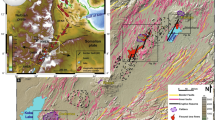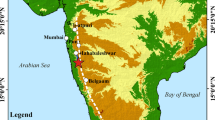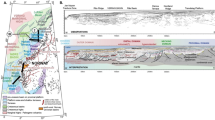Abstract
The East African Rift System transects the anomalously high-elevation Ethiopian and East African plateaux that together form part of the 6,000-km-long African superswell structure. Rifting putatively developed as a result of mantle plume activity that initiated under eastern Africa. The mantle activity has caused topographic uplift that has been connected to African Cenozoic climate change and faunal evolution. The rift is traditionally interpreted to be composed of two distinct segments: an older, volcanically active eastern branch and a younger, less volcanic western branch. Here, we show that initiation of rifting in the western branch began more than 14 million years earlier than previously thought, contemporaneously with the eastern branch. We use a combination of detrital zircon geochronology, tephro- and magnetostratigraphy, along with analyses of past river flow recorded in sedimentary rocks from the Rukwa Rift Basin, Tanzania, to constrain the timing of rifting, magmatism and drainage development in this part of the western branch. We find that rift-related volcanism and lake development had begun by about 25 million years ago. These events were preceded by pediment development and a fluvial drainage reversal that we suggest records the onset of topographic uplift caused by the African superswell. We conclude that uplift of eastern Africa was more widespread and synchronous than previously recognized.
This is a preview of subscription content, access via your institution
Access options
Subscribe to this journal
Receive 12 print issues and online access
$259.00 per year
only $21.58 per issue
Buy this article
- Purchase on Springer Link
- Instant access to full article PDF
Prices may be subject to local taxes which are calculated during checkout




Similar content being viewed by others
References
Pik, R. East Africa on the rise. Nature Geosci. 4, 660–661 (2011).
Moucha, R. & Forte, A. M. Changes in African topography driven by mantle convection. Nature Geosci. 4, 707–712 (2011).
Nyblade, A. in Volcanism and the Evolution of the African Lithosphere (eds Beccaluva, L., Bianchini, G. & Wilson, M.) 37–50 (Geological Society of America Special Paper Vol. 478, 2011).
Nyblade, A. & Robinson, S. The African superswell. Geophys. Res. Lett. 21, 765–768 (1994).
Burke, K. The African plate. S. Afr. J. Geol. 99, 339–409 (1996).
Ebinger, C. J. & Sleep, N. Cenozoic magmatism throughout East Africa resulting from impact of a single plume. Nature 395, 788–791 (1998).
Sepulchre, P. et al. Tectonic uplift and eastern Africa aridification. Science 313, 1419–1423 (2006).
Spiegel, C., Kohn, B. P., Belton, D. X. & Gleadow, A. J. W. Morphotectonic evolution of the central Kenya rift flanks: Implications for late Cenozoic environmental change in East Africa. Geology 35, 427–430 (2007).
Pik, R, Marty, B., Carignan, J., Yirgu, G. & Ayalew, T. Timing of East African Rift development in southern Ethiopia: Implication for mantle plume activity and evolution of topography. Geology 36, 167–170 (2008).
Ebinger, C. J. Tectonic development of the western branch of the East African rift system. Geol. Soc. Am. Bull. 101, 885–903 (1989).
Flowers, R. & Schoene, B. (U–Th)/He thermochronometry constraints on unroofing of the eastern Kaapvaal craton and significance for uplift of the southern African Plateau. Geology 38, 827–830 (2010).
Burke, K. The Chad Basin: An active intra-continental basin. Tectonophysics 36, 197–206 (1976).
Goudie, A. S. The drainage of Africa since the Cretaceous. Geomorphology 67, 437–456 (2005).
Pik, R., Marty, B., Carignan, J. & Lavé, J. Stability of the upper Nile drainage network (Ethiopia) deduced from (U–Th)/He thermochronometry: Implications for uplift and erosion of the Afar plume dome. Earth Planet. Sci. Lett. 215, 73–88 (2003).
Stankiewicz, J. & de Wit, M. J. A proposed drainage evolution model for central Africa—did the Congo flow east? J. Afr. Earth Sci. 44, 75–84 (2006).
Gani, N. D. S., Gani, M. R. & Abdelsalam, M. G. Blue Nile incision on the Ethiopian Plateau: Pulsed plateau growth, Pliocene uplift and hominin evolution. GSA Today 17, 4–11 (2007).
Furman, T., Kaleta, K. M., Bryce, J. G. & Hanan, B. B. Tertiary mafic lavas of Turkana, Kenya: Constraints on East African plume structure and the occurrence of high-μ volcanism in Africa. J. Petrol. 47, 1221–1244 (2006).
Ebinger, C. J., Yemane, T., Woldegabriel, G., Aronson, J. L. & Walter, R. C. Late Eocene–Recent volcanism and faulting in the southern main Ethiopian Rift. J. Geol. Soc. Lond. 150, 99–108 (1993).
McDougall, I. & Brown, F. H. Timing of volcanism and evolution of the northern Kenya Rift. Geol. Mag. 146, 34–47 (2009).
Ayalew, D. et al. Source, genesis, and timing of giant ignimbrite deposits associated with Ethiopian continental flood basalts. Geochem. Cosmochim. Acta 66, 1429–1448 (2002).
George, R., Rogers, N. & Kelley, S. Earliest magmatism in Ethiopia: Evidence for two mantle plumes in one flood basalt province. Geology 26, 923–926 (1989).
Foster, A., Ebinger, C., Mbede, E. & Rex, D. Tectonic development of the northern Tanzanian sector of the East African Rift System. J. Geol. Soc. Lond. 154, 689–700 (1997).
Ebinger, C., Deino, A., Drake, R. & Tesha, A. Chronology of volcanism and rift basin propagation: Rungwe Volcanic Province, East Africa. J. Geophys. Res. 94, 15785–15803 (1989).
Morley, C. K. et al. Tectonic evolution of the northern Kenyan Rift. J. Geol. Soc. Lond. 149, 333–348 (1992).
Ebinger, C. J. et al. Rift deflection, migration, and propagation: Linkage of the Ethiopian and Eastern rifts, Africa. Geol. Soc. Am. Bull. 112, 163–176 (2000).
Chorowicz, J. The East African Rift System. J. Afr. Earth Sci. 43, 379–410 (2005).
Wolfeden, E., Ebinger, C., Yirgu, G., Deino, A. & Ayalew, D. Evolution of the northern Main Ethiopian Rift: Birth of a triple junction. Earth Planet. Sci. Lett. 224, 213–228 (2004).
Cohen, A. S., Soreghan, M. J. & Scholz, C. A. Estimating the age of formation of lakes: An example from Lake Tanganyika, East African Rift System. Geology 21, 511–514 (1993).
Tiercelin, J. J. & Lezzar, K. E. in The East African Great Lakes: Limnology, Palaeolimnology and Biodiversity (eds Odada, E. O. & Olago, D. O.) 3–60 (Kluwer Academic, 2002).
Kilembe, E. A. & Rosendahl, B. R. Structure and stratigraphy of the Rukwa Rift. Tectonophysics 209, 143–158 (1992).
Wescott, W. A., Krebs, W. N., Engelhardt, D. W. & Cunningham, S. W. New biostratigraphic age dates from the Lake Rukwa Rift Basin in western Tanzania. Am. Assoc. Pet. Geol. Bull. 75, 1255–1263 (1991).
Morley, C. K., Cunningham, S. M., Harper, R. M. & Westcott, W. A. in Geoscience of Rift Systems—Evolution of East Africa (ed. Morley, C. K.) 91–110 (Studies in Geology 44, American Association of Petroleum Geologists, 1999).
Delvaux, D. in The Karoo to Recent Rifting in the Western Branch of the East-African Rift System: A Bibliographical Synthesis 63–83 (Royal Museum of Central Africa, Belgium, 1991).
Nyblade, A. A. & Brazier, R. A. Precambrian lithospheric controls on the development of the East African Rift System. Geology 30, 755–758 (2002).
Tiercelin, J. J. et al. East African Rift System: offset, age and tectonic significance of the Tanganyika–Rukwa–Malawi intracontinental transcurrent fault zone. Tectonophysics 148, 241–252 (1988).
Batumike, J. M. et al. LAM-ICPMS U-Pb dating of kimberlitic perovskite: Eocene–Oligocene kimberlites from the Kundelungu Plateau, D.R. Congo. Earth Planet. Sci. Lett. 267, 609–619 (2008).
Bauer, F. U., Glasmacher, U. A., Ring, U., Schumann, A. & Nagudi, B. Thermal and exhumation history of the central Rwenzori Mountains, Western Rift of the East African Rift System, Uganda. Int. J. Earth Sci. 99, 1575–1597 (2010).
Van der Beek, P., Mbede, E., Andriessen, P. & Delvaux, D. Denudation history of the Malawi and Rukwa rift flanks (East African Rift System) from fission track thermochronology. J. Afr. Earth Sci. 26, 363–385 (1998).
Belton, D. X. The Low Temperature Chronology of Cratonic Terrains PhD thesis, Univ. Melbourne (2006).
Stevens, N. J., O’Connor, P. M., Gottfried, M. D., Roberts, E. M. & Ngasala, S. An anthropoid primate from the Paleogene of southwestern Tanzania. J. Vert. Paleontol. 25, 986–989 (2005).
Stevens, N. J. et al. in Elwyn Simmons: A Search for Origins. Developments in Primatology: Progress and Prospects (eds Fleagle, J. G. & Gilbert, C. C.) 159–180 (Springer, 2008).
Roberts, E. M. et al. Sedimentology and depositional environments of the Red Sandstone Group, Rukwa Rift Basin, southwestern Tanzania: New insight into Cretaceous and Paleogene terrestrial ecosystems and tectonics in sub-equatorial Africa. J. Afr. Earth Sci. 57, 179–212 (2010).
O’Connor, P. M. et al. The evolution of mammal-like crocodyliforms in the cretaceous of Gondwana. Nature 466, 748–751 (2010).
Cahen, L. Geologie du Congo Belge (Vaillant-Carmanne, 1954).
Sahagian, D. Epeirgeonic motions of Africa as inferred from Cretaceous shoreline deposits. Tectonics 7, 125–138 (1988).
Rosenthal, A., Foley, S. F., Pearson, D. G., Nowell, G. M. & Tappe, S. Petrogenesis of strongly alkaline primitive rocks at the propagating tip of the western branch of the East African Rift. Earth Planet. Sci. Lett. 284, 236–248 (2009).
Hilton, D. R. et al. Helium isotopes at Rungwe Volcanic Province, Tanzania and the origin of the East African Plateaux. Geophys. Res. Lett. 38, L21304 (2011).
Hanson, R. E. in Proterozoic East Gondwana: Supercontinent Assembly and Breakup (eds Yoshida, M., Windley, B. F. & Dasgupta, S.) 427–463 (Geol. Soc. Lond., 2003).
De Waele, B., Kampunzu, A. B., Mapani, B. S. E. & Tembo, F. The Mesoproterozoic Irumide belt of Zambia. J. Afr. Earth Sci. 46, 36–70 (2006).
Ogg, J. G. & Smith, A. G. in A Geologic Time Scale 2004 (eds Gradstein, F. M., Ogg, J. G. & Smith, A. G.) 63–86 (Cambridge Univ. Press, 2004).
Acknowledgements
Financial support was provided by the National Science Foundation (EAR-0617561), L. S. B. Leakey Foundation, National Geographic Society (Committee for Research and Exploration), James Cook University, Ohio University and Michigan State University. We thank T. Blenkinsop for a constructive review; T. Hieronymus, Z. Jinnah, S. Ngasala, E. Johansen and J. Temba for field assistance; Y. Hu and K. Blake for technical support in the Advanced Analytical Centre; G. Messe and T. Barnum for help with palaeomagnetic measurements; the Tanzanian Commission for Science and Technology and the Tanzanian Antiquities Unit for logistical support.
Author information
Authors and Affiliations
Contributions
E.M.R., P.M.O., N.J.S. and M.D.G. developed the project and collected the field data. E.M.R., P.M.O., N.J.S., P.G.H.M., M.D.G. and W.C.C. developed the scientific concepts, interpreted the data and wrote the paper. R.A.A., A.I.S.K., S.H. and E.M.R. carried out the radio-isotopic dating. W.C.C. carried out palaeomagnetic analyses.
Corresponding author
Ethics declarations
Competing interests
The authors declare no competing financial interests.
Supplementary information
Supplementary Information
Supplementary Information (PDF 15042 kb)
Supplementary Information
Supplementary Information (XLS 33 kb)
Supplementary Information
Supplementary Information (XLSX 17 kb)
Supplementary Information
Supplementary Information (XLS 30 kb)
Supplementary Information
Supplementary Information (XLSX 17 kb)
Supplementary Information
Supplementary Information (XLSX 427 kb)
Supplementary Information
Supplementary Information (PDF 521 kb)
Supplementary Information
Supplementary Information (PDF 195 kb)
Rights and permissions
About this article
Cite this article
Roberts, E., Stevens, N., O’Connor, P. et al. Initiation of the western branch of the East African Rift coeval with the eastern branch. Nature Geosci 5, 289–294 (2012). https://doi.org/10.1038/ngeo1432
Received:
Accepted:
Published:
Issue Date:
DOI: https://doi.org/10.1038/ngeo1432
This article is cited by
-
Probabilistic seismic hazard assessment framework for Uganda: a stochastic event-based modelling approach
Bulletin of Earthquake Engineering (2024)
-
GIS-based landslide susceptibility mapping of Western Rwanda: an integrated artificial neural network, frequency ratio, and Shannon entropy approach
Environmental Earth Sciences (2023)
-
Cretaceous–Quaternary seismic stratigraphy of the Tanga offshore Basin in Tanzania and its petroleum potential
Journal of Petroleum Exploration and Production Technology (2022)
-
Geologic review of hydrocarbons potential of the Rufiji Basin, Tanzania
Journal of Sedimentary Environments (2022)
-
Assessment of the Kiejo-Mbaka geothermal field by three-dimensional geophysical modelling
Geomechanics and Geophysics for Geo-Energy and Geo-Resources (2022)



